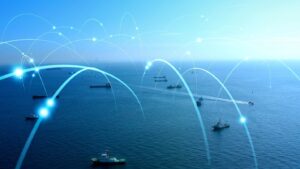Overview:
- Vessel-to-shore integration transforms ships into connected, data-driven platforms.
- Ship connectivity solutions, maritime cloud services, and vessel monitoring technology enable real-time collaboration.
- Centralized IT management improves efficiency, safety, and crew experience.
- Robust cybersecurity and compliance are essential for protecting maritime operations.
- Partnering with expert MSPs like Atekro ensures successful implementation and ongoing support.
This blog explores how maritime organizations can successfully connect vessel and shore systems to create a unified, efficient, and secure operational environment. Vessel-to-shore integration enables real-time data exchange, remote support, and centralized fleet management by seamlessly linking shipboard systems with shore-based IT platforms.
Ships are no longer isolated units navigating the oceans independently; they are rapidly evolving into connected, data-driven platforms integrated with onshore operations. This evolution, often referred to as the “floating office” concept, represents a shift from traditional vessel operations to a model where crews, systems, and management tools are fully synchronized with shore-based infrastructure. The result is improved efficiency, enhanced safety, and a more sustainable maritime ecosystem.
With advancements in high-speed connectivity like Starlink, cloud computing, IoT sensors, and AI-driven analytics, vessels can now operate in close collaboration with shore teams. These technologies enhance ship to shore communication, enabling real-time data exchange and faster, better-informed decisions. For maritime operators, partnering with an MSP like Atekro to embrace these technologies ensures a smoother transition to modern, integrated operations—keeping pace with an industry increasingly shaped by digital workflows.
Understanding the floating office concept
As maritime operations become increasingly digitized, the concept of a “floating office” is redefining how vessels interact with shore-based teams. As of 2025, most modern vessels are equipped with complex networks that monitor machinery, navigation systems, communications, cargo handling, and even crew welfare.
These systems generate vast amounts of data that can be transmitted to shore-based teams, enabling real-time visibility of vessel operations. In a fully integrated model, onboard processes—such as engine performance monitoring, fuel management, and navigation—and IT systems are connected to cloud-based platforms.
Shore teams can monitor operations continuously, access performance dashboards, and guide the crew remotely. This integration, supported by a reliable shore connection, allows for proactive decision-making, where potential issues are detected before they escalate, reducing the risk of costly downtime or operational disruptions.
For crews, this transformation brings the same IT experience they would have in a corporate office. Email, collaboration tools, reporting systems and more are all accessible from the vessel, ensuring that the crew works in harmony with their onshore counterparts.
Why is high-speed connectivity essential
Vessels require reliable high-speed internet connectivity. Maritime operators are increasingly investing in satellite-based communication systems, such as Starlink, and emerging 5G maritime networks to ensure uninterrupted data flow.
Ship connectivity solutions allow vessels to access cloud-hosted IT services, conduct video conferences, receive remote technical support, and share operational data with shore teams in real time.
By moving critical IT functions, such as email and collaboration platforms, to the cloud, operators reduce onboard IT complexity and maintenance costs. Crews benefit from seamless access to these services while also enjoying connectivity for entertainment and personal communication.
High-speed maritime internet connectivity is carefully managed to ensure that leisure or entertainment activities do not consume excessive bandwidth, allowing operational processes to function without interruption. This approach ensures that your crew can stay connected, productive, and engaged, no matter where the vessel is in the world.
Centralized fleet IT management improves security, compliance, and operational oversight, while providing a balanced environment where both operational efficiency and crew welfare are maintained.

Continuous IT system monitoring and remote support
Digital integration enables continuous oversight of vessel IT systems, including networks, servers, communication platforms, and cloud-based applications. Systems are monitored in real time to detect potential issues before they impact operations. This continuous monitoring ensures that IT infrastructure remains reliable, secure, and fully aligned with operational requirements.
In addition to the vessel monitoring technology, remote support allows any identified issues to be addressed without physical visits to the vessel. Configurations can be adjusted, updates deployed, and problems resolved from a distance, minimizing downtime and ensuring uninterrupted access to critical digital services.
By combining continuous monitoring with remote support, fleets benefit from improved operational efficiency, enhanced cybersecurity, and consistent compliance with regulatory and operational standards. This approach ensures vessels can operate safely, reliably, and seamlessly, with all IT systems fully integrated with shore-based processes.
What are the benefits of maritime cloud services?
Maritime cloud services bring major efficiency and flexibility to fleet operations. They simplify IT management, enhance crew productivity, and keep vessels up to date with the latest technology.
- Cloud hosting removes the need for separate IT systems on each vessel.
- Centralized management allows easy updates, backups, and security control across the fleet.
- Crew members can handle reporting and document management directly onboard.
- Operational reports sync automatically with shore systems, saving time and reducing errors.
- Cloud platforms scale easily as fleets grow or new technologies appear.
- This flexibility keeps operations efficient and competitive..
Cybersecurity and compliance considerations
With increased connectivity come heightened cyber threats to vessels. Vessels integrated with shore IT systems are vulnerable to cyberattacks that could compromise operations, safety, or sensitive information. Implementing robust cybersecurity measures—including 24/7 cyber threat monitoring, firewalls, encryption, multi-factor authentication, and crew training—is critical to protecting data integrity.
Regulatory maritime cybersecurity regulations are equally important. Operators must adhere to maritime standards such as IMO, coast guard guidelines, and industry-specific cybersecurity frameworks.

Conclusion
Vessel-to-shore integration is transforming maritime operations by improving efficiency, safety, and the overall crew experience. To stay competitive in this changing environment, maritime operators should invest in vessel connectivity solutions and cloud-based IT services. They should also use continuous vessel monitoring technology to ensure smooth and safe operations. Strong cybersecurity measures and regulatory compliance must remain top priorities to protect data and maintain trust. Partnering with a managed service provider like Atekro ensures expert maritime IT support, helping operators stay reliable, secure, and future-ready. Contact us today to explore tailored maritime IT solutions that connect your vessels and shore operations for a smarter, safer future.
About the author:
Scott’s journey from decades in IT to founding Atekro reflects his passion for helping businesses grow with tailored technology solutions.
Frequently Asked Questions
What is vessel-to-shore integration?
Vessel-to-shore integration connects shipboard IT systems with shore-based infrastructure for real-time data sharing and operational oversight.
How do vessel connectivity solutions improve maritime operations?
Vessel connectivity solutions improve maritime operations by enabling real-time data exchange, remote diagnostics, centralized IT management, and seamless collaboration between ship crews and shore teams.
Why is cybersecurity important in maritime IT systems?
Increased connectivity exposes vessels to cyber threats. Robust cybersecurity protects data and ensures compliance.
How do cloud solutions benefit vessel operations?
Cloud computing centralizes IT management, simplifies updates, and allows crews to access essential tools and reports from anywhere.
Can remote support reduce vessel downtime?
Yes, remote IT support enables quick troubleshooting and updates, minimizing the need for physical visits.
Love This Article? Share It!
Learn how implementing SPF, DKIM, and DMARC protocols can protect your business from phishing, spoofing threats, and improve your email deliverability, ensuring your messages reach the right inbox every time.
Ransomware poses a major risk to businesses, causing costly downtime and damage to your reputation. Strengthen your defense and ensure continuity with proactive security and effective recovery strategies.
Starlink’s high-speed, low-latency internet is challenging VSAT’s dominance. This blog explores their differences and impact on maritime communication.
Choosing between MSPs and Break-Fix IT companies affects your business’s efficiency and growth. Our blog outlines the pros and cons to help you select the model that best aligns with your goals.
We compare Microsoft 365 and Google Workspace across key areas like cybersecurity, productivity, cloud storage, user-friendliness, administration, and cost. Find out which suite best meets your business needs.
Optimize IT operations with Microsoft Intune’s cloud-based device management and policy control, remote work support, and seamless integration with other Microsoft services to boost productivity and enhance security.
A password manager can streamline your security by storing all your credentials in one encrypted vault, simplifying logins with a single master password. Discover implementation tips for enhancing your digital security.
Ransomware attacks are on the rise, threatening businesses of all sizes. Discover how to defend your business with practical tips on preventing attacks and maintaining resilience.
Gain clarity as an accountant on the FTC Safeguards Rule and its implications for your business's data security. Discover effective strategies to ensure your company meets regulatory standards.
Discover six actionable tech tips to enhance your accounting firm's efficiency and security. From cloud adoption to cybersecurity, stay ahead of the curve.
STAY IN THE LOOP
Subscribe to our free newsletter.












